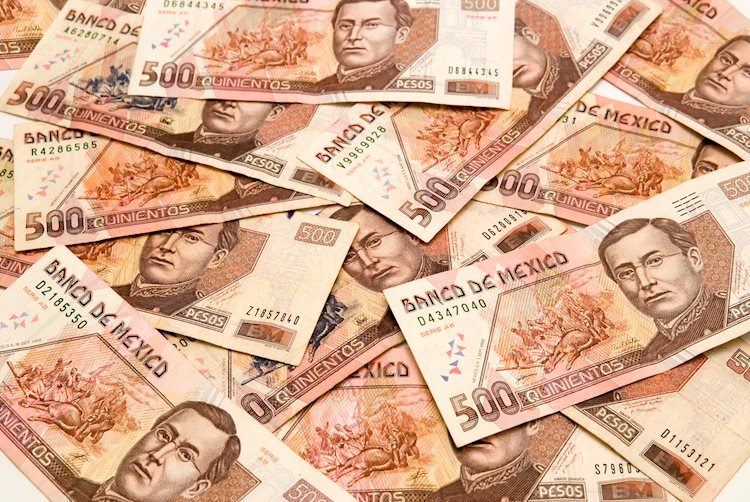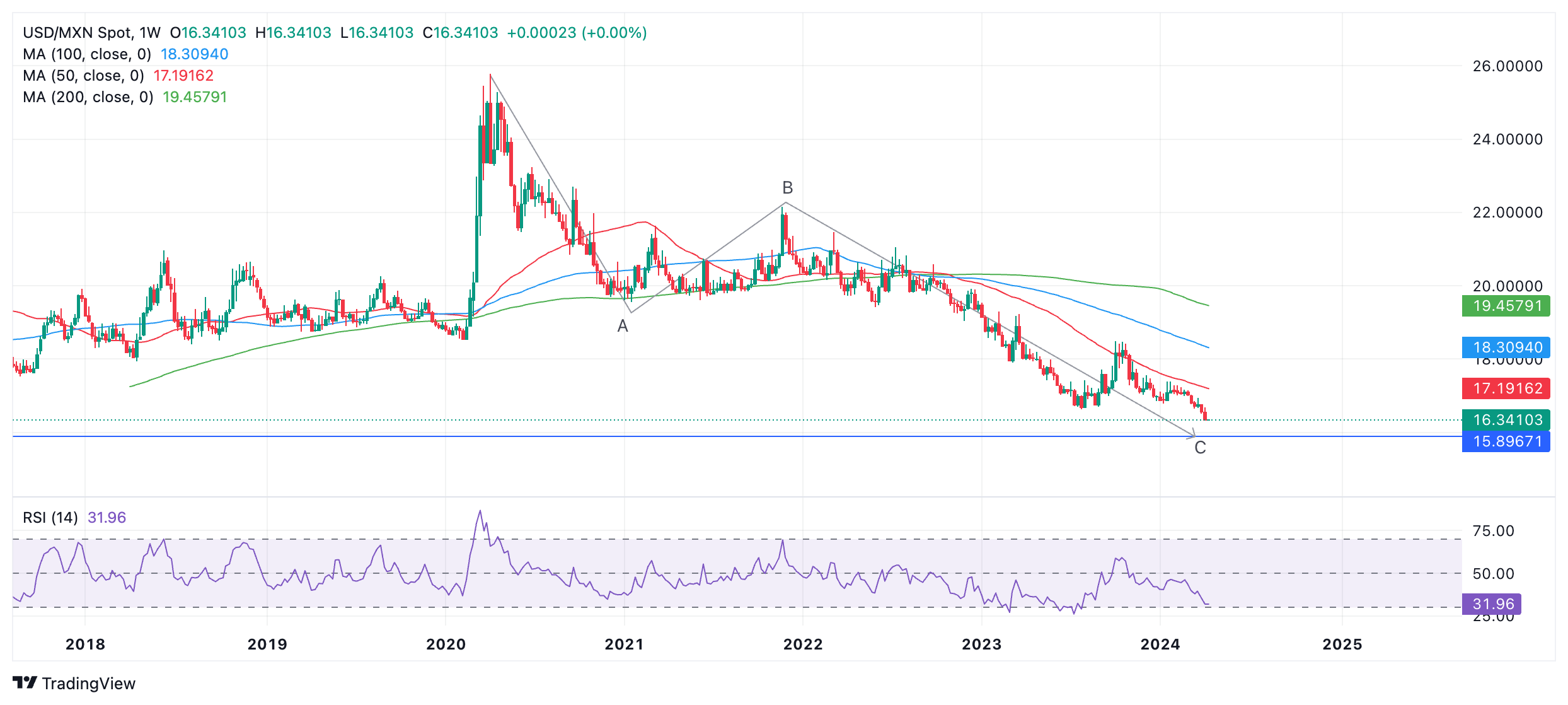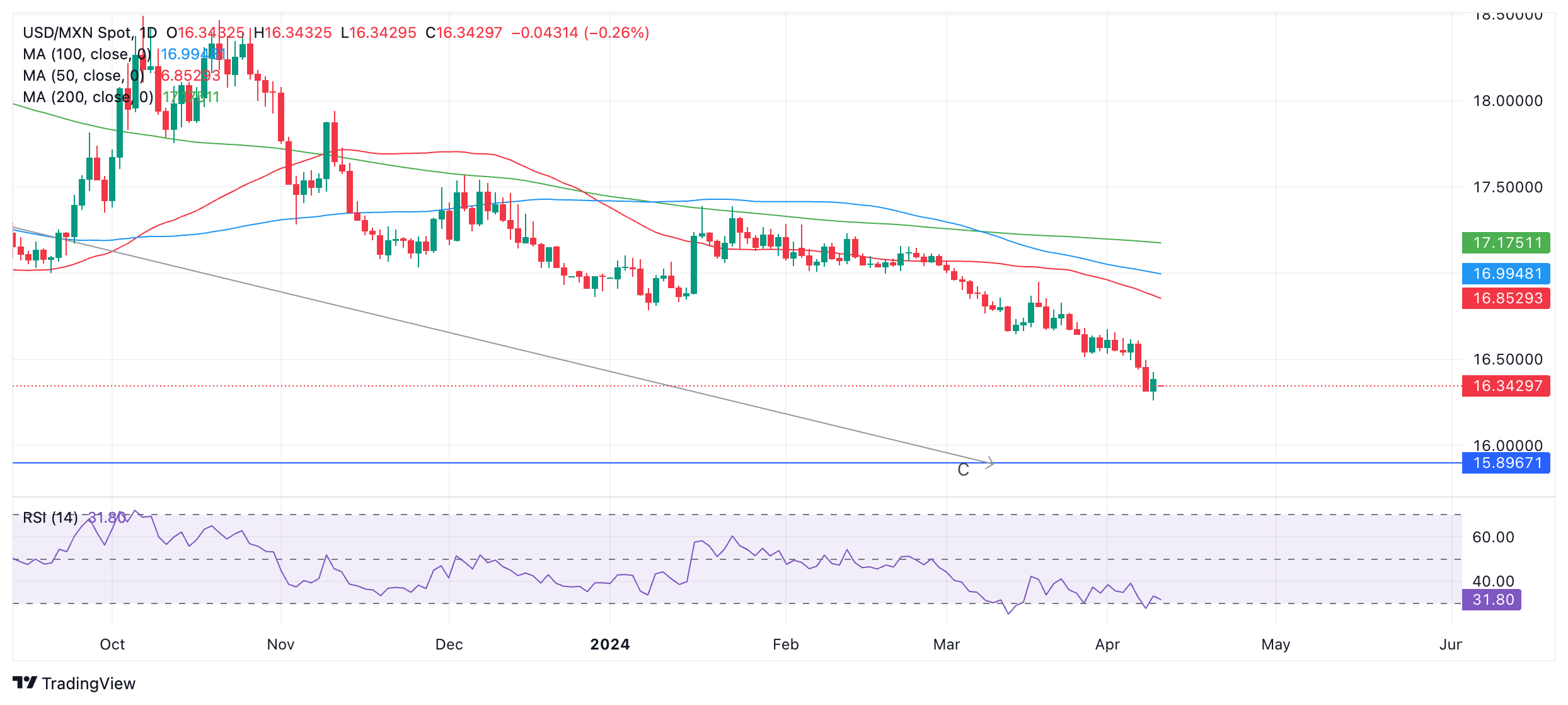- The Mexican Peso has resumed its uptrend despite cooler-than-expected inflation data for March.
- The slowdown in price pressures was not substantial enough to change the overall outlook for monetary policy.
- Interest rates, a key FX driver, are likely to remain elevated in Mexico, supporting the Peso going forward.
The Mexican Peso (MXN) is trading higher in most pairs on Wednesday, in line with the long-term trend of the currency. It has already undone the losses of the previous day when cooler-than-expected inflation data for March marginally raised the possibility of lower interest rates by the Bank of Mexico (Banxico).
Mexican Peso continues rising on interest rate divergence
The Mexican Peso has developed a long-term uptrend on the back of relatively high interest rates in Mexico, which help attract inflows of foreign capital.
Although the Banxico cut its Overnight Interbank Target Rate from 11.25% to 11.00% in March, it did so without committing to further rate cuts.
The move came on the back of lower trending inflation, however, the meeting minutes revealed the view that the balance of risks continue tilting in favor of inflation remaining stubbornly high going forward. This will likely require the Banxico to keep interest rates at their relatively high level, continuing to underpin the MXN.
This week sees the release of Industrial Production and Retail Sales data on Thursday and Friday respectively, for Mexico. Neither are in themselves likely to move the Mexican Peso, but they will provide more intelligence on the performance of the economy.
High-than-expected macroeconomic data will likely buttress the Mexican Peso. Banxico said that despite higher interest rates, the economy continues showing a high degree of “dynamism” and resilience and data that backs up that view. This will probably mean the central bank keeps interest rates at their relatively elevated level for longer.
US CPI data could impact USD/MXN
The Mexican Peso versus the US Dollar pair (USD/MXN) could also experience added volatility on Wednesday from the release of US Consumer Price Index data at 12:30 GMT, during the US session.
Economists expect prices in the US to have risen by 3.4% year-over-year in March and 3.7% YoY for the core measure, which excludes volatile food and energy prices.
A higher-than-expected result would be supportive of USD/MXN and vice versa for the lower-than-forecast result.
Technical Analysis: USD/MXN extends downtrend
USD/MXN is in a long-term downtrend which began in April 2020 after the pair peaked at 25.76, and has since fallen to the 16.30s. Given the old adage that “the trend is your friend,” it is likely to continue lower.
The pair is probably unfolding a large three-wave price pattern called a Measured Move. These patterns are composed of an A, B, and C wave, with wave C extending to a similar length to wave A, or a Fibonacci 0.618 ratio of A.
USD/MXN Weekly Chart
If this is the case, price has almost reached the point at which C will equal A, calculated at 15.89.
It has also by now surpassed the conservative target for the end of C at the 0.618 Fibonacci extension of A (at 18.24).
Once the pattern is complete the market usually reverses or undergoes a substantial correction.
The Relative Strength Index (RSI) is converging acutely with price – a sign the downtrend could be losing momentum. In 2024, USD/MXN has pushed lower than the 2023 lows but the RSI has not followed suit. This non-correlation is a bullish indication. It could lead to a correction higher eventually.
There has been no reaction from prices yet, however, so the expectation of upside remains speculatory and unconfirmed.
USD/MXN Daily Chart
The daily chart shows more recent activity in greater detail. A feature worth noting is the RSI, which has risen out of oversold territory. This recommends that short-holders trading over an intermediate time frame (3-6 months) should close their short bets and open longs.
Taken together with the bullish convergence on the weekly chart this may signal USD/MXN is about to begin a correction higher.
The lack of any other bullish signs from price itself, however – such as a bullish reversal candlestick pattern, for example – suggest bulls should be cautious before expecting more upside.
Also, given the strong downtrend, the signal from the RSI momentum indicator is likely to be less reliable, since RSI does not work as effectively in strongly trending markets.
Mexican Peso FAQs
The Mexican Peso (MXN) is the most traded currency among its Latin American peers. Its value is broadly determined by the performance of the Mexican economy, the country’s central bank’s policy, the amount of foreign investment in the country and even the levels of remittances sent by Mexicans who live abroad, particularly in the United States. Geopolitical trends can also move MXN: for example, the process of nearshoring – or the decision by some firms to relocate manufacturing capacity and supply chains closer to their home countries – is also seen as a catalyst for the Mexican currency as the country is considered a key manufacturing hub in the American continent. Another catalyst for MXN is Oil prices as Mexico is a key exporter of the commodity.
The main objective of Mexico’s central bank, also known as Banxico, is to maintain inflation at low and stable levels (at or close to its target of 3%, the midpoint in a tolerance band of between 2% and 4%). To this end, the bank sets an appropriate level of interest rates. When inflation is too high, Banxico will attempt to tame it by raising interest rates, making it more expensive for households and businesses to borrow money, thus cooling demand and the overall economy. Higher interest rates are generally positive for the Mexican Peso (MXN) as they lead to higher yields, making the country a more attractive place for investors. On the contrary, lower interest rates tend to weaken MXN.
Macroeconomic data releases are key to assess the state of the economy and can have an impact on the Mexican Peso (MXN) valuation. A strong Mexican economy, based on high economic growth, low unemployment and high confidence is good for MXN. Not only does it attract more foreign investment but it may encourage the Bank of Mexico (Banxico) to increase interest rates, particularly if this strength comes together with elevated inflation. However, if economic data is weak, MXN is likely to depreciate.
As an emerging-market currency, the Mexican Peso (MXN) tends to strive during risk-on periods, or when investors perceive that broader market risks are low and thus are eager to engage with investments that carry a higher risk. Conversely, MXN tends to weaken at times of market turbulence or economic uncertainty as investors tend to sell higher-risk assets and flee to the more-stable safe havens.


